In modern foreign language pedagogy, we tend to not teach “grammar” directly. We want our students to naturally acquire grammar through comprehensible input and authentic texts. One of the best strategies to do this is with children’s books spanish lessons. Children’s books tend to use repetition of similar phrases and sentence structure over and over again. So, we can easily use children’s books in Spanish to introduce and reinforce grammar structures.
From past tense to direct object pronouns (and everything in between), you can use children’s books Spanish versions as the center of your “grammar” lessons. I’ve gathered some of the best children’s books in Spanish to teach grammar. Check out the synopsis of each story below plus my recommendations for post-reading activities so students can take the text one step further and apply the grammar in authentic ways.
I was fortunate enough to discover most of these books at Scholastic Warehouse sales, where you can fill a box with books for only $25! I’m always amazed at how large the Spanish section of the fill-a-box section was. I also happened to stumble across a few of these at library book sales or yard sales. Here are my favorite spots to find books to build a classroom library on a budget.
Present Tense Children’s Books
The perfect storm of present tense and cultural comparisons can be found in Querido primo by Duncan Tonatiuh. This is the story of two cousins, one from Mexico and the other from the United States who write letters to one another. They share stories of their traditions, games, food, celebrations, and more. With simple present tense and beautiful illustrations, your students will easily comprehend what Carlitos and Charlie’s lives are like.
Post-Reading Activities
As students read, you can have them keep track of the Mexican culture elements that they hear. They can jot down ideas and then you can create a long list together as a class. Once the list is complete, now they can compare their life to Carlito’s life in Mexico. Have your students create a drawing with Carlitos on one side and themselves on the other. Then, they can write a short description of their comparison. They should focus on one aspect like school, games, holidays, etc. in their comparison.
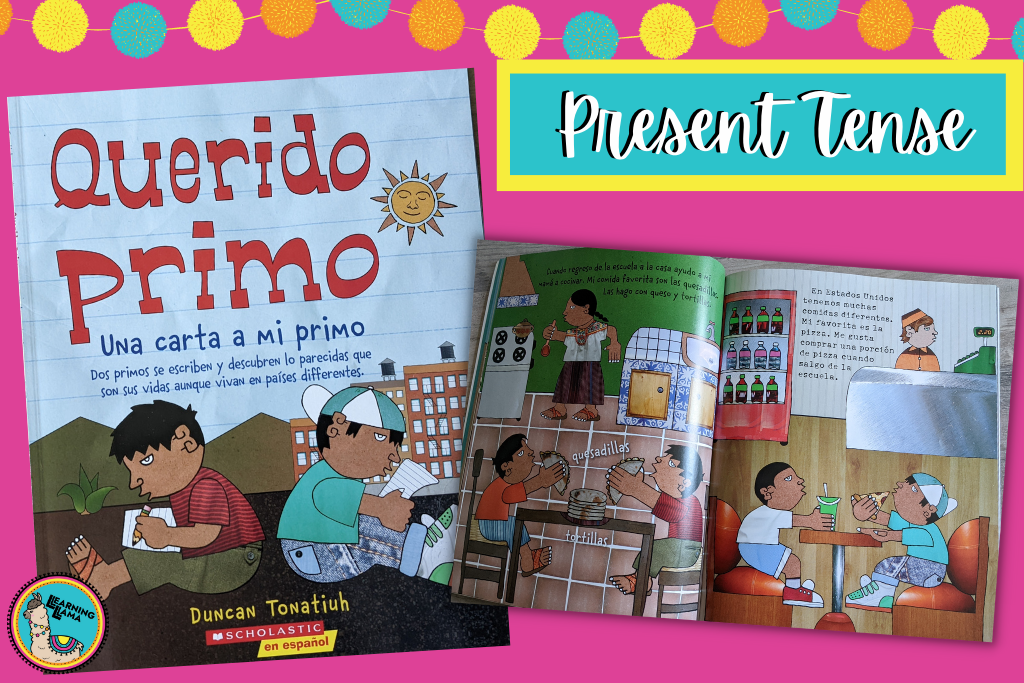
Preterit vs. Imperfect Spanish Children’s Books
When teaching preterit vs imperfect, my students and I always read at least three stories to see the grammar concepts in use. Many fairy tales and short stories incorporate the preterit and imperfect naturally, so children’s books really lend themselves to this unit. First, I make sure my students understand the difference between the two forms of the past tense. Then, we read stories and identify where we see each tense used, and more importantly why. For example, students will begin to notice that the imperfect tense is used mainly at the beginning of the story to set up the scene and describe characters. While the preterit is used for single actions, throughout the story.
One of my favorite books is “Cuentos Revueltos,” which I got at a Scholastic Warehouse sale. During my first year of teaching preterit vs imperfect, I made the mistake of using classic fairy tales that my students knew by heart in English. I don’t know if they actually read them in Spanish with me or just relied on previous knowledge. Needless to say, the following year, something had to change. Cuentos revueltos was a lifesaver. It took classic stories like Little Red Riding Hood or The Ugly Duckling and put a spin on them! Now, I’ve searched and searched online to find it, but I cannot. But let this book serve the purpose of being the reason why you should NOT just use traditional fairy tales that your students already know by heart!
La llorona is a classic Hispanic legend about the woman whose children drowned in a lake. It is a great spooky story that will keep your students engaged from the beginning until the end. This version of La llorona by Joe Hayes does a great job of using the imperfect to introduce the story and characters. Then once the action starts happening, switches to preterit. It’s just how I explain preterit and imperfect to my students, so that’s why I love using this story.
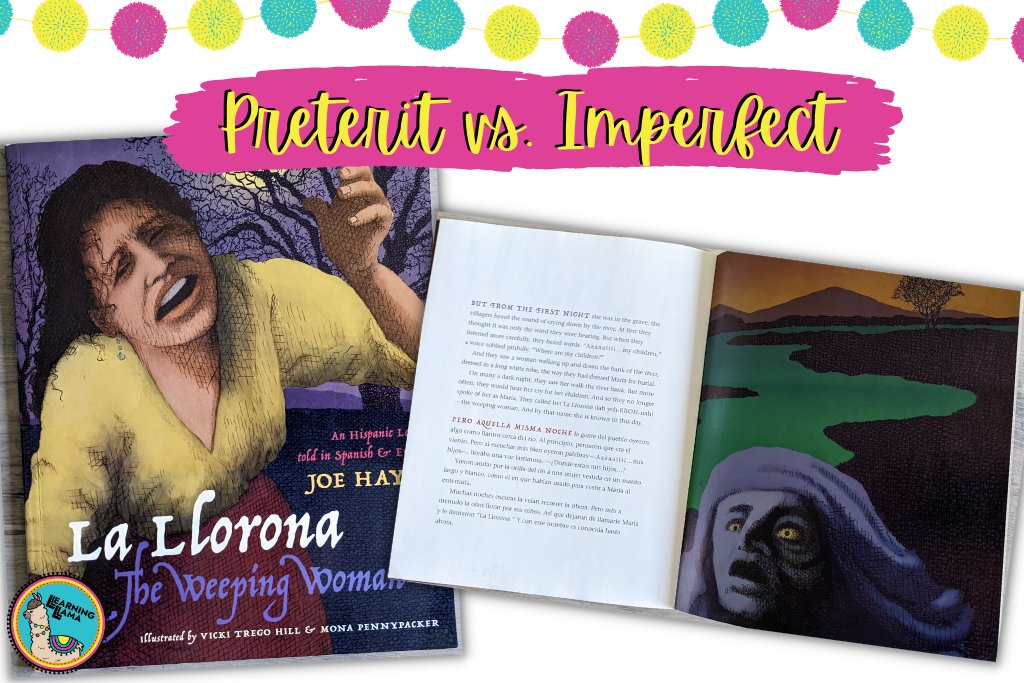
Post-Reading Activities
Now, your students are ready to write their own fairy tale, legend, or short story! I always conclude my preterit and imperfect lesson with this write your own fairy tale project. They have seen the imperfect being used to introduce characters and setting. Then a switch to the preterit comes when the plot picks up. They will use those same rules in their own story telling. Learn more about my preterit and imperfect lessons here.
Future Tense Children’s Books
If You Give a Mouse a Cookie is a classic story! Si le das una galletita a un raton, the Spanish version is just as adorable! With the repetition of sentence structure over and over again, it will really help your students to understand the formation of the future tense. Almost every sentence uses the future tense!
Post-Reading Activities
I know there are other similar stories, like If You Give a Moose a Muffin, or If You Give a Pig a Pancake, but you can still have your students create their own short stories. They can choose any animal and any object. Maybe change the object from food to something else so they have to use more creativity. For example, if you give an elephant a pencil… They’ll be using the future tense and also doing some very creative writing!
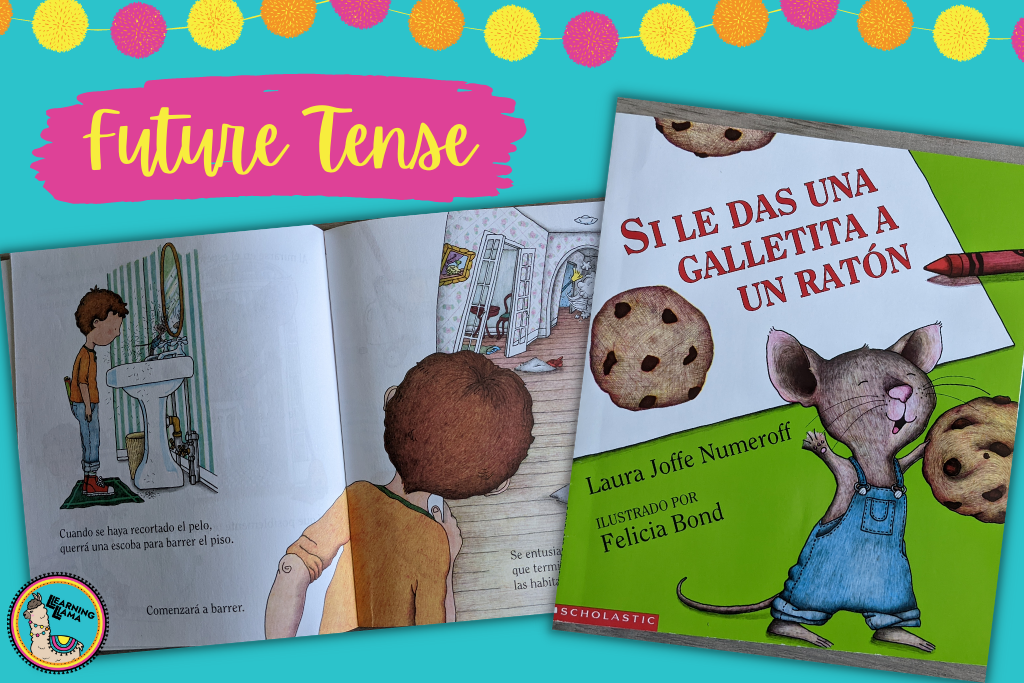
Commands
David va a la escuela is a very basic story that will demonstrate affirmative and negative commands with school vocabulary. David is a mischievous student who doesn’t know how to behave at school. He hears all sorts of commands like “Raise your hand!” and “Don’t chew gum!” in Spanish. This story also works really well at the beginning of the year when setting classroom expectations!
Post Reading Activities
Either during or after reading, have students categorize the commands into affirmative and negative lists. If you haven’t yet introduced the rules of forming commands, this would be a great time for them to induce the rules themselves. Can they make any educated guess as to how to form the commands?
After you have read David va a la escuela with your students, you can have them add additional commands to the story. This would be a great entire-class project, where you work together to create your own story book. Each student could create a page with commands and images to teach students how to behave in school. Another option is for your students to choose other locations like park, zoo, supermarket, church, etc. Then they write their own story like Paula va a la iglesia or Ramón va al zoológico. Students will write a similar book, with both affirmative and negative commands!
Reflexive Verbs
Froggy se viste is a perfect tie-in to a reflexive verbs lesson or daily routine unit. With verbs like despertarse, ponerse, calzarse, quitarse, and more, your students will read about Froggy getting ready to go play in the snow! He keeps forgetting a layer of clothing, so he is taking on and off all of his winter layers. It is a story in the past tense, but a great story nonetheless, even for beginner students.
I actually began using this with elementary students when we were learning clothing vocabulary. As I read the story, they would each have small pieces of paper with the different clothing Froggy would wear (boots, scarf, hat, etc.) As I read each line, they would hold up the clothing that Froggy was putting on or taking off. This task helped to keep them actively engaged in the story, with something very specific to listen for.
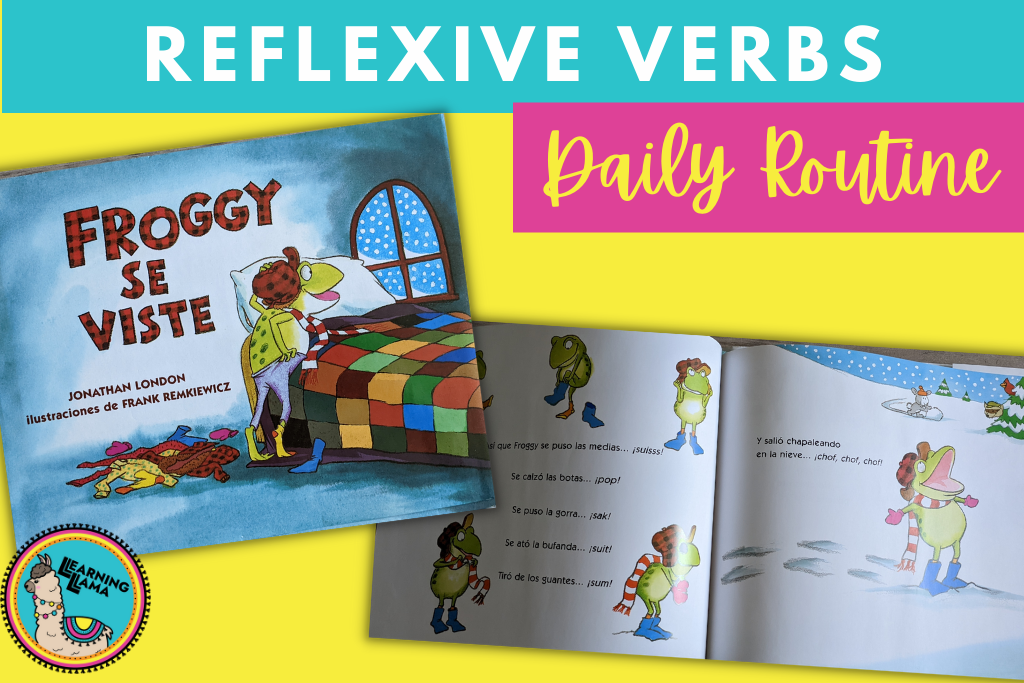
Post-Reading Activities
You can have your students describe how they get ready for a different season of weather or a different activity. What clothing do they put on to go to the beach? What do they wear when going to a Christmas party?
For presentational speaking, you can provide each student with printable images of the clothing that Froggy wears. They can use the images to retell the story in their own words and practice forming the reflexive verbs on their own.
Conditional Tense
Huevos verdes con jamon by Dr. Seuss is a story that they have likely heard many times before and could even recite to you in English. But rather than reading this book for comprehension, they are really reading to hear the repetition of the conditional tense.
Direct Object Pronouns
You can also use Huevos verdes con jamon when teaching Direct Object Pronouns as well! “No los quiero en un cajón, no los como aquí ni allá.” The sentence structure with direct object pronouns can take students a while to grasp, since it is literally backwards from English. So hearing it repeated over and over again can help solidify the word order.
Ir + a + Infinitive
When teaching ir + a + infinitive, students usually make a list of things they are going to do or we have them plan a party, identifying who will do what during the preparations. Manana Iguana is an ENGLISH book – but when I taught 6th grade Spanish, I translated the book myself. It didn’t take that long. I scanned the pages into my computer and then added my own text boxes to cover the text. It was the perfect story for a unit on party planning and ir + a + infinitive, so I knew the little bit of extra work would be worth it. Iguana is left to do all of the party planning by herself as her friends come up with countless excuses. ¡Ella va a hacer todo!
Have you read any of these Children’s Books Spanish versions before? What other books should I add to my list to teach grammar in a comprehensible way?
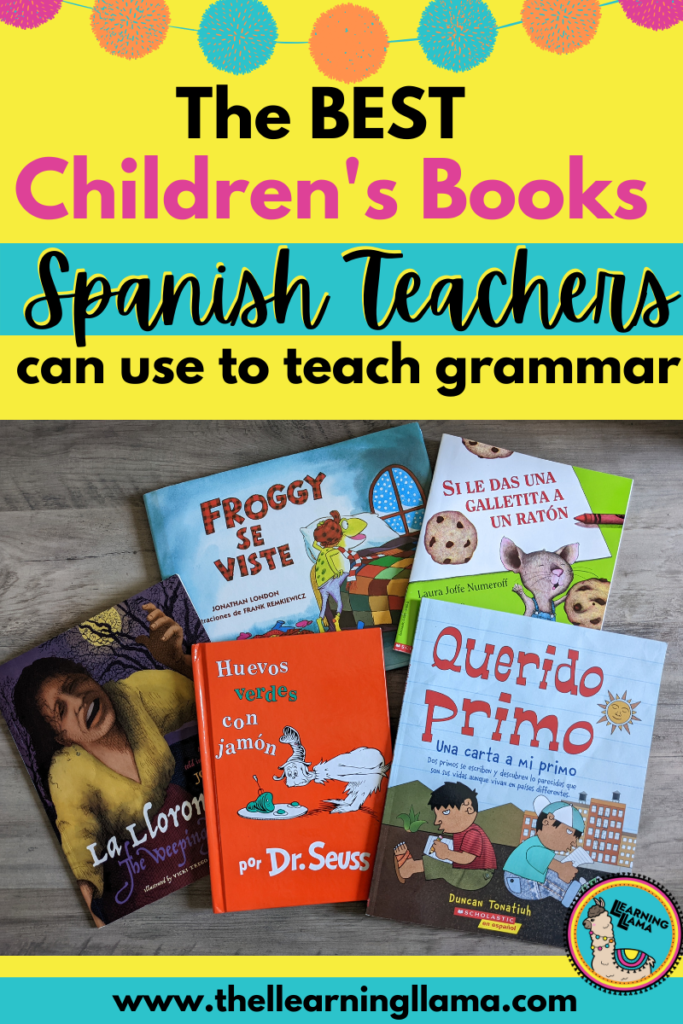

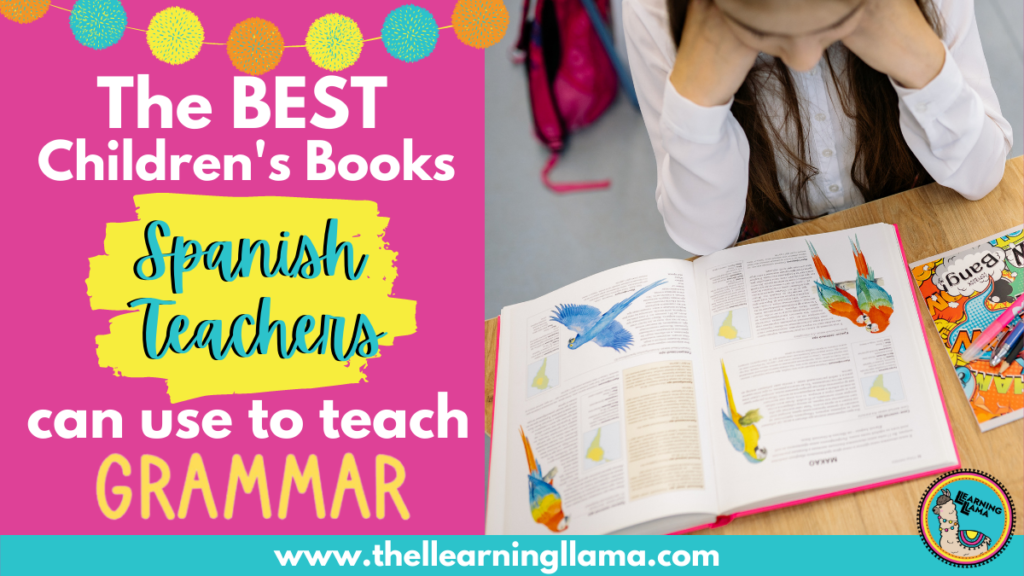

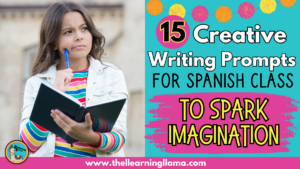
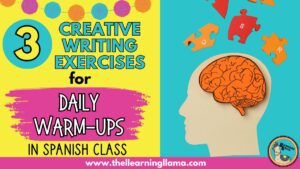

One Response